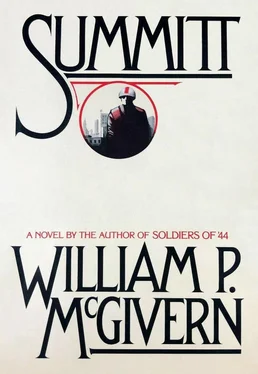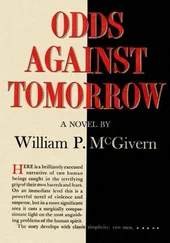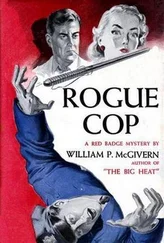Mooney’s secretary said she would be glad to take care of it.
That evening Selby looked through the material he had collected from Miss Culpepper, trying to find the connection between Harlequin Chemicals and his father and brother. George Thomson (Tomaso) had started a garbage and waste recycling plant on the Schuylkill River years ago, but had sold the controlling interest to a conglomerate called the Correll Group. George Thomson had served in Korea. That was mentioned in several of the articles.
Harlequin Chemicals had grown and prospered enormously after its takeover by the Correll Group.
There were profiles of Simon Correll in Fortune and several other periodicals, detailing his wealth and entrepreneurial genius.
The Correll Group had offices in a dozen major cities and extensive ties to the major sources of power throughout the world, the military, of course, and energy, science and industry. A story in Newsweek mentioned that Correll often cited an incident in London involving a stricken dog and a blind woman as turning his energies to the world’s needs for more tranquil, more safe living spaces, more rational and sustaining human environmental systems, free of abhorrent and perverse chance.
None of it meant a damn thing to Selby, or related to what he was concerned with. At least so far as he could see...
He made himself a drink and stirred the fire. There’d been a fireplace in the house where Shana had been taken, a deer’s head over the mantel. The man had played loud music on a record player, he’d shouted at her and some of it seemed like poetry. She’d told the nurse that much...
The phone rang. It was Jay Mooney. “Dammit, Harry, why are you trying to screw me up? Don’t you know I can’t mess with those people at City Hall? I depend on those cops... every insurance man does... for accident reports, hit-runs, makes on plates, like you asked Annie for. That bull about getting your fender nicked could’ve got my ass nailed to the floor. Your story’s a crock. They wanted to know why I’m checking up on one of their own people, Lieutenant Gus Eberle. Harry? You still there?”
“Sure, Jay.” Mooney was a bit drunk, his words were slurred together, fused with righteous anger and whiskey. “So it was Lieutenant Eberle tailing me around,” Selby said.
“Didn’t you hear me? Eberle and Slocum run that shop, close, I can’t afford a hassle with them. Annie called the Motor Bureau with that plate number. I got a call back from Slocum, that’s right, the captain himself. He wants to know who’s running checks on Eberle and why . I lied, Harry. Told him Annie’d got a digit misplaced, that it was a mistake. You got to cover for me. Forget you asked us to check out that plate. Okay?”
“Sure, Jay. But I’d appreciate some background on Captain Slocum and Eberle first.”
“Some of it’s common knowledge, Harry. Slocum’s a mean sonofabitch. He’s rich, which should tell you something. Owns condos over in Avalon and a high-rise in Atlantic City. But look, Harry, I can’t get involved. You understand? Those people are real sons of bitches—”
Davey came in from the foyer with a large book that Selby recognized as a volume produced by the County Historical Society. As Davey knelt beside the coffee table and opened the book Selby said to Mooney, “Could we have lunch tomorrow?”
“I told you, Harry, I can’t get mixed up in this. You’re either a team player or a fink at the Hall. Oh, hell, know a place called the Bluebonnet on the Mercer Pike? Say around one o’clock?”
When Selby hung up, Davey said, “Can I show you something?”
He opened the book and flipped the pages. “I got to thinking while I was trying to sleep, dad. About tunnels. I figured a tunnel had to go under something, like the railroad tunnel near Doylestown, or under something like maybe sewers or something. But everything around here is wells. I mean, that’s where the water comes from, wells and those water rams. Right?”
Selby watched Davey turning the pages of the book. Smart boy. Only nine... “So, what did you find out, Davey?”
“A tunnel doesn’t always go under something. It could go over something, too. And then I remembered the bridge over the White Clay Creek. Look, dad...” He pointed to a faded black-and-white photograph. “It’s about five miles from the Stoneville school and it’s on the same road as the switching yards in Buck Run. I bet that’s the tunnel Shana’s trying to tell us about. What do you think, dad?”
“I think, Davey, I’ve got myself one smart kid. We’ll check it out.”
The Rakestraw Bridge had been designed by a local architect, Charles Rakestraw, in 1885. Construction was completed by the Union Iron Company two years later. A sturdy fifty-foot span, it was built with iron rails and locust logs and covered with an arch of curved and seasoned planks which had weathered gray over the decades.
The Buck Run Road crossed the Rakestraw Bridge and dead-ended on the opposite side of the creek against Dade Road, a wide, two-lane blacktop.
Selby’s station wagon made a rumbling noise as he drove onto the bridge. It’s high roof cut off most of the early morning light, and for an instant he traveled through a long, dark cylinder with a glowing circle of light at its end.
Shana’s tunnel, no doubt, he thought as he came into the daylight. But where from here?
About a quarter of a mile to his right was the Brandywine Lakes Country Club, a complex of houses and sports facilities, private and expensive. The community was known locally as The Lakes.
At the entrance to The Lakes a large billboard displayed aerial photographs of the fairways and swimming pools. The string of pools was like a blue necklace strung among the dark lawns and green belts. Selby noticed a name in the corner of the photographic display: “Creative Photography, J. D. Parks, East Chester.”
In the opposite direction on Dade Road heavy woods stretched for miles with homes set back on lots screened by trees. A cemetery sloped down to the creek, slate-colored headstones glinting in the morning sun. Further on the countryside opened up and the meadows were bordered by thick stands of timber. The land was as yet untouched by the construction boom churning up the countryside.
He parked beside the cemetery and looked at the headstones stretching down to the water, some slanted with age, the letters and dates worn smooth as moss.
So far this morning he had seen nothing of Eberle’s gray Ford. He waited beside the White Clay Creek for an hour or so, occasionally checking the rear-view mirror, then drove on home.
Shana was lying on her bed in the dark. Her radio was turned so low that the music almost faded out when occasional winds struck the house. In the glow from the dial Selby saw that she was staring at the ceiling, her arms crossed on her narrow chest.
He had the historical society’s book with him. “Can I turn on a light, Shana? I want to show you something.”
“All right, just a minute.”
She went into her bathroom and closed the door. Water ran in her hand basin. Her room had been straightened up and smelled of talcum powder.
When Shana came out he saw that she had combed her hair. There were damp grooves in the blond waves. She had changed the bandage on her right hand; the strips of gauze and adhesive tapes were white against her tanned skin. A heavy lock of hair was combed to slant sideways and cover a pink welt on her forehead.
Her mood had changed from the day before; the anger and hostility seemed to have faded somewhat.
Selby showed her the picture of the Rakestraw Bridge. “This is probably the tunnel you talked about. It might help if you remembered which way you went when you crossed it. If you turned right, you’d have been heading for Brandywine Lakes. To the left is a different stretch of country.”
Читать дальше

![Уильям Макгиверн - Завтра опять неизвестность [английский и русский параллельные тексты]](/books/35168/uilyam-makgivern-zavtra-opyat-neizvestnost-angli-thumb.webp)









